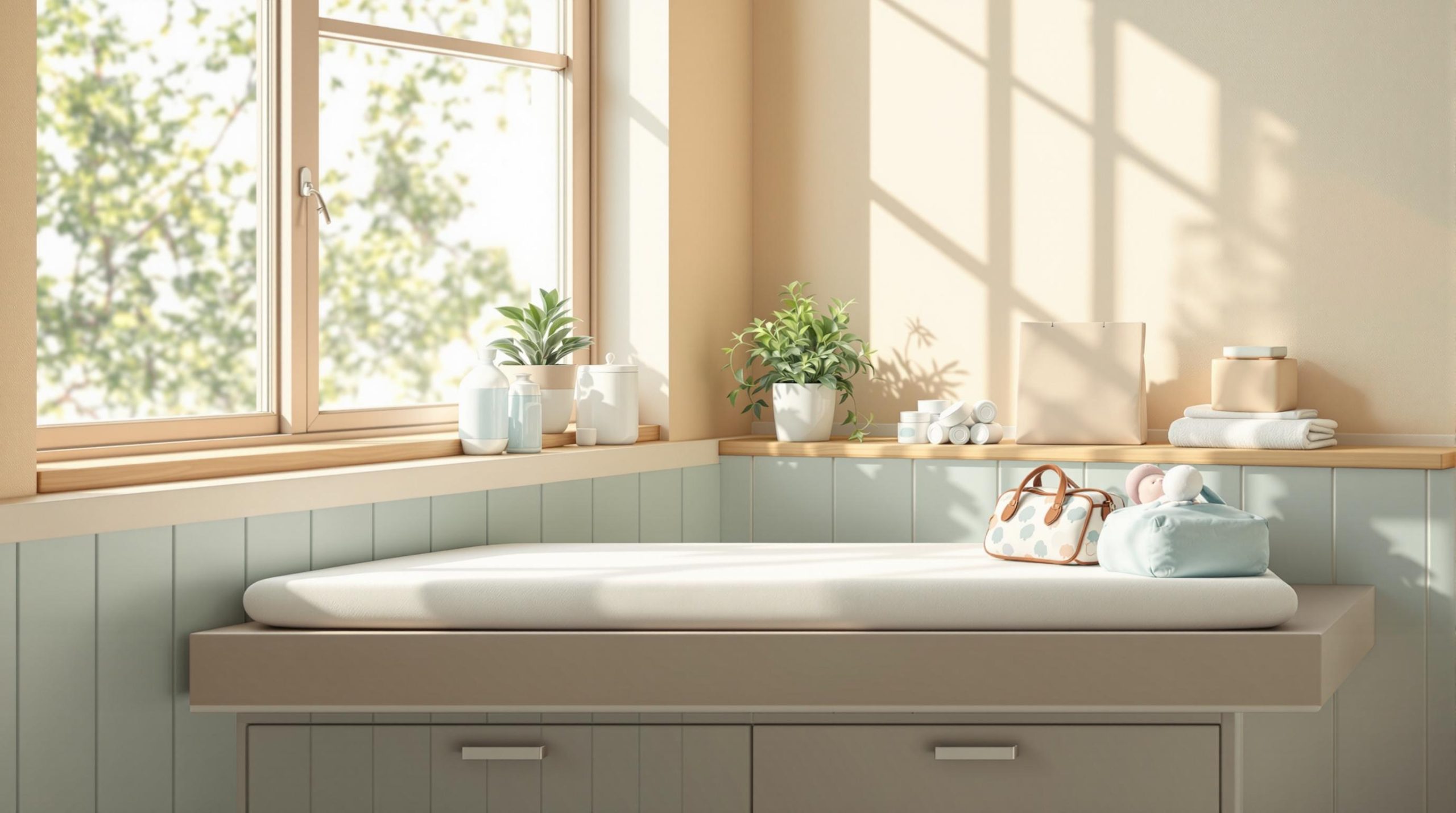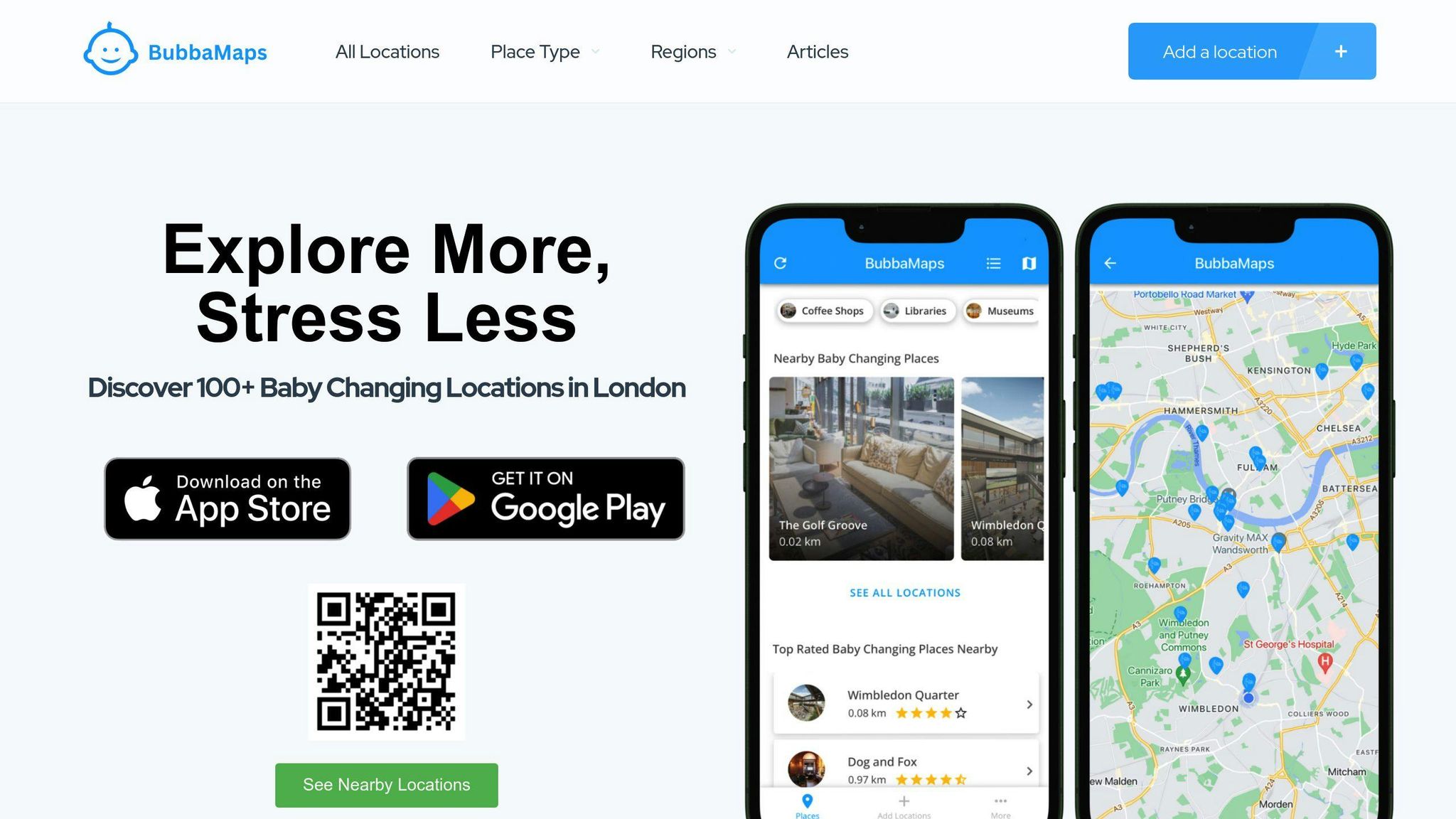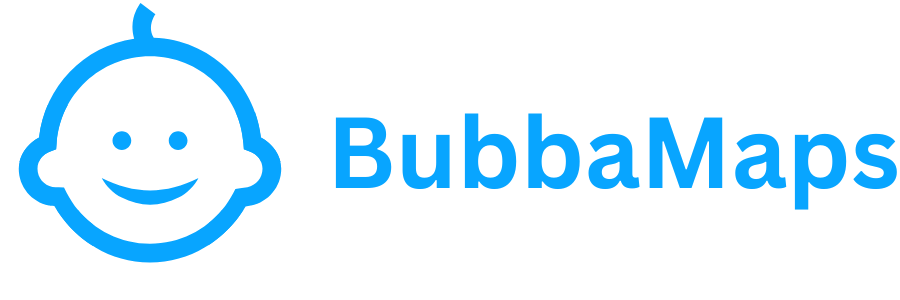
Essential Checklist for Using Public Baby Changing Rooms
Public baby changing rooms can be unpredictable in terms of cleanliness and amenities. To ensure a safe and hassle-free experience for you and your baby, here’s what you need to know:
- Pack Smart: Bring diapers, wipes, a portable changing mat, hand sanitizer, disposal bags, and extra clothes for emergencies.
- Stay Hygienic: Clean the changing surface with sanitizing wipes, use safety straps, and wash or sanitize your hands before and after changes.
- Be Prepared for Challenges: Handle tight spaces with compact gear, keep older siblings occupied, and adapt if amenities are missing.
- Use Tools Like BubbaMaps: Find nearby baby changing facilities with detailed reviews and ratings to save time and reduce stress.
The Good and Bad of Baby Changing Facilities
What to Pack for Public Baby Changing Rooms
Having a well-prepared changing bag can make navigating public baby changing rooms much easier. Here’s what seasoned parents and hygiene experts suggest you include.
Diapers, Wipes, and a Portable Changing Mat
Pack enough diapers – one for every hour you’re out, plus two extras. A travel-sized pack of baby wipes (10-20 wipes) should cover most outings. A portable changing mat is a must-have. It provides a clean barrier between your baby and potentially unsanitary public changing surfaces.
"One assumption all cleaning professionals should make is that parents do not properly clean the changing station after each use." – Multi-Clean
As highlighted by Multi-Clean, public changing stations are often not thoroughly cleaned. A waterproof, easy-to-clean mat can help protect your baby from germs.
Hand Sanitizer and Disposal Bags
Good hand hygiene is crucial in public spaces. Bring an alcohol-based hand sanitizer (at least 60% alcohol) that’s gentle enough for frequent use. You’ll also need:
- Plastic bags for soiled diapers and wipes
- Disposable gloves for added hygiene
- Sanitizing wipes to clean surfaces
These items help ensure cleanliness and make diaper changes more manageable.
Extra Clothes and Emergency Supplies
Prepare for unexpected messes by packing:
- A full change of clothes for your baby
- An extra shirt for yourself
- A waterproof wet bag for soiled clothes
- A small first-aid kit with band-aids and wipes
With these essentials in your bag, you’ll be ready to handle most situations that come your way.
Tips for Staying Clean and Safe in Shared Spaces
Public changing rooms require extra care to ensure a hygienic and safe experience for both you and your baby. Here’s how you can make shared spaces safer and cleaner.
Inspect and Prepare the Changing Area
Public changing surfaces can harbor harmful bacteria. Before use, check the station for visible dirt or damage. Use sanitizing wipes to clean the surface thoroughly, paying close attention to corners and hinges. Let it dry completely before placing your changing mat.
Use Safety Straps Properly
Safety straps on public changing stations are there for a reason but are often ignored or used incorrectly. Here’s what to do:
- Make sure the straps are in good condition and work as intended.
- Secure the straps snugly around your baby’s midsection.
- Stay physically engaged with your baby – don’t rely on straps alone.
If straps are broken or missing, report the issue to staff immediately. Facility guidelines emphasize that fully functional safety restraints are essential for keeping babies secure.
Keep an Eye on Your Baby at All Times
Always supervise your baby closely when using public facilities. Keep everything you need – like diapers, wipes, and a changing bag – within reach before starting. Remove any potential hazards in the area and stay focused on your baby. Avoid distractions, such as checking your phone, during the process.
How to Handle Common Problems in Public Facilities
Even with the best planning, public facilities can throw unexpected challenges your way. Here’s how to tackle them smartly.
Managing Tight Spaces
Dealing with cramped areas? A compact changing pad with built-in storage can be a lifesaver, keeping essentials within reach while making the most of the available surface. Hang your diaper bag on hooks or place it on shelves if possible. If your stroller reclines flat, it can double as a makeshift changing station. In a pinch, a portable changing mat on a clean bench works just as well.
Small spaces can be tough, but juggling multiple kids during diaper changes adds its own set of challenges.
Keeping Older Siblings Occupied
Keeping older kids busy while changing diapers is all about preparation. Give them simple "helper" tasks, like holding a clean diaper or passing wipes. This keeps them engaged and makes them feel like part of the process, reducing the chance of them wandering off or getting bored.
What to Do When Amenities Are Missing
Missing essentials? Here are a few quick fixes:
- Use disposable changing pads for a clean surface.
- Keep an extra set of clothes within easy reach.
- Turn your stroller into a temporary changing station.
- Seek out family restrooms, which often have more space and better amenities.
If a facility is poorly equipped, let the management know. Your feedback can help improve the experience for other parents.
sbb-itb-a5e9dda
How BubbaMaps Can Help You Find Baby Changing Rooms

BubbaMaps makes it simple to locate baby changing facilities in London, offering access to over 100 verified locations through its mobile app. It’s a handy tool that saves time and reduces the stress of searching for suitable changing rooms.
Finding Nearby Facilities with BubbaMaps
The app provides all the key details you need, including addresses, opening hours, amenities, cleanliness ratings, and user reviews – all sorted by proximity for easy access. Here’s what each listing includes:
| Information Type | Details Provided |
|---|---|
| Basic Details | Address, opening hours, facility type |
| Amenities | Available equipment, cleanliness status |
| Access | Directions, parking availability |
| Community Input | Recent user ratings, latest reviews |
Using and Writing Reviews on BubbaMaps
Parent reviews are a great way to assess the quality of a facility. After using a baby changing room, you can share your feedback on cleanliness, available amenities, and safety. This helps keep the app’s information accurate and assists other parents in finding reliable facilities.
Navigation Tools and Other Features
BubbaMaps includes features like search filters for specific needs, turn-by-turn navigation, offline access, and photos of facilities. These tools make it easier to locate and evaluate baby changing rooms, including family restrooms, when standard options aren’t ideal.
While BubbaMaps helps you find the right facilities, practicing good etiquette ensures these spaces stay clean and welcoming for everyone.
Good Manners in Public Baby Changing Rooms
Clean Up After Yourself
Research has found that changing stations often carry bacteria like E. coli. Always dispose of waste in the proper bins, wipe down the surface with antibacterial wipes, and double-check that you haven’t left behind any trash or personal items.
"Public baby changing stations are a modern convenience that helps millions of traveling families every day. Parents must clean stations after use to prevent the spread of germs." – PublicRestroom.Lifetips.com
Report Problems to Staff
If you notice broken safety straps, missing supplies, cleanliness issues, or damaged equipment, let the staff know. This helps maintain safe and sanitary spaces for all families. Carrying your own sanitizing wipes and disposal bags can also make it easier to clean up and leave the area ready for the next user.
Be Considerate of Others
Show respect for other parents by being efficient, organized, and mindful of the shared space. Here are a few tips:
- Be quick: Finish your routine promptly, especially if others are waiting.
- Stay organized: Keep your belongings tidy and out of the way.
- Keep it calm: Try to maintain a quiet atmosphere for others nearby.
- Use supplies wisely: Take only what you need from the provided items.
Conclusion: Be Ready and Make Outings Easier
After looking at tools like BubbaMaps and practicing good etiquette, it’s clear that being prepared can make outings much smoother. With initiatives like the BABIES Act increasing the availability of facilities, knowing how to use these resources effectively is more important than ever.
Taking a planned approach helps make public changing facilities easier to use. By preparing ahead and using the right tools, you can turn a potentially stressful experience into a manageable routine. Digital tools simplify finding and accessing facilities, while community efforts ensure these spaces remain clean and functional.
"The health and safety of our children is a priority for every parent. In the face of threats related to bacteria and viruses that can lurk practically everywhere, hand hygiene becomes a basic step in taking care of health."
Here are some key aspects to keep in mind for a successful outing:
| Essential Aspect | Why It Matters |
|---|---|
| Preparation | Reduces stress and ensures readiness |
| Hygiene | Protects health and prevents illness |
| Digital Tools | Helps locate facilities quickly |
| Community Care | Keeps shared spaces usable for everyone |
Using pH-neutral cleaners and following proper sanitization practices is a simple way to support everyone’s safety. With more venues offering accessible changing stations, parents now have better options to meet their needs.
FAQs
Here are answers to some common questions about baby changing facilities and how to use them safely.
What should baby changing facilities include?
A good baby changing facility should have the following:
| Item | Purpose |
|---|---|
| Sturdy changing unit | Provides a stable and safe surface for diaper changes. |
| Waste bin | Allows proper disposal of diapers and wipes. |
| Space with bag hooks | Offers room to move around and keeps bags off the floor. |
| Hand washing station | Helps maintain hygiene. |
| Safety straps | Keeps the baby secure during changes. |
| Proper ventilation | Ensures fresh air circulation. |
The BABIES Act mandates these facilities in federal buildings, and states like California and New York have adopted similar rules for public spaces.
How do you clean a public baby changing table?
When using a public changing table, follow these steps to ensure cleanliness:
- Inspect the surface: Look for any visible dirt or damage.
- Clean thoroughly: Use a mild cleaning solution to wipe the surface, then dry it completely with a clean cloth.
Make sure to sanitize your hands both before and after the diaper change to reduce the spread of germs.













